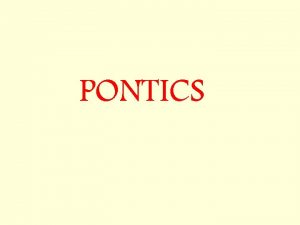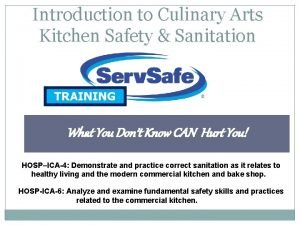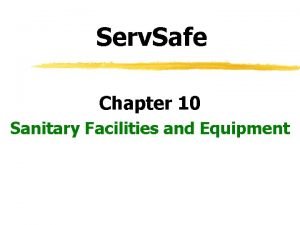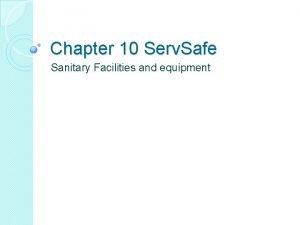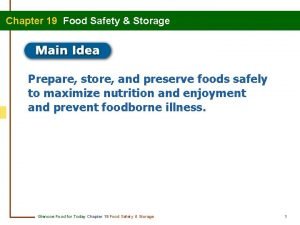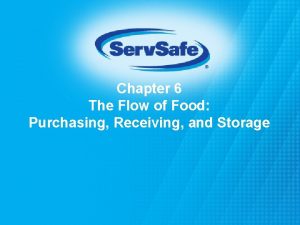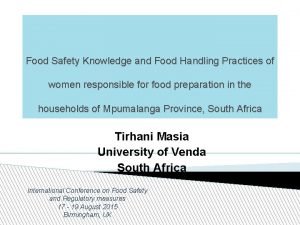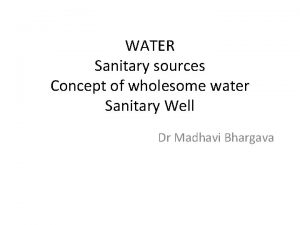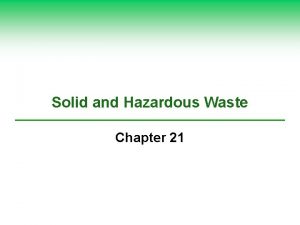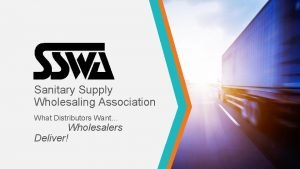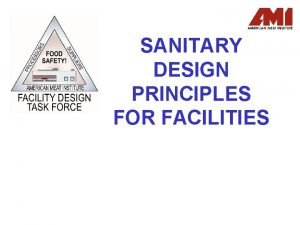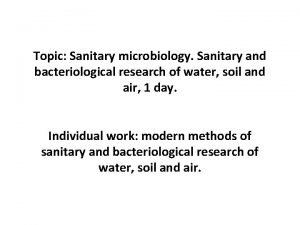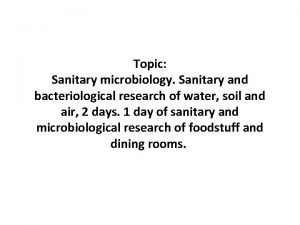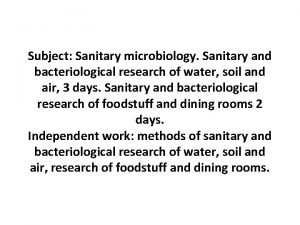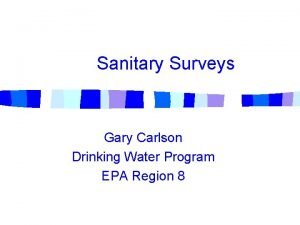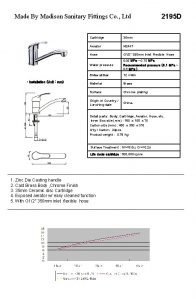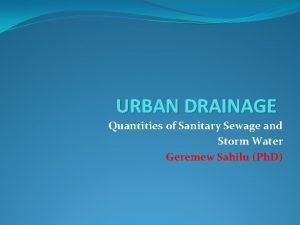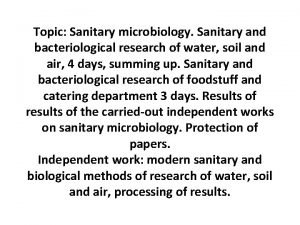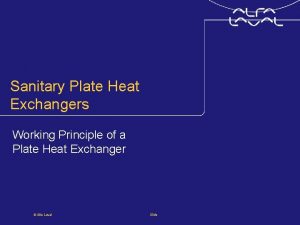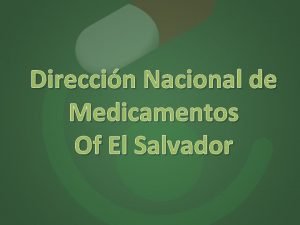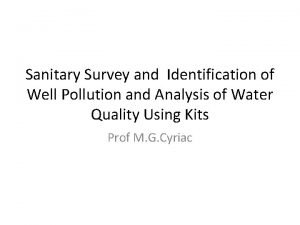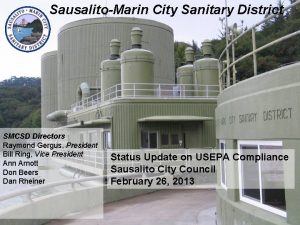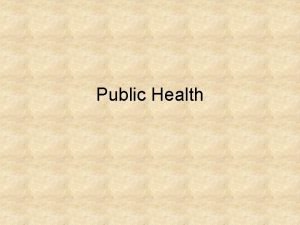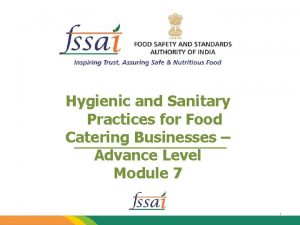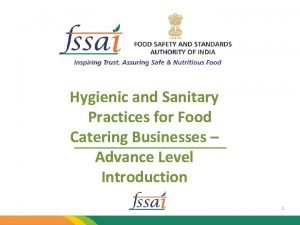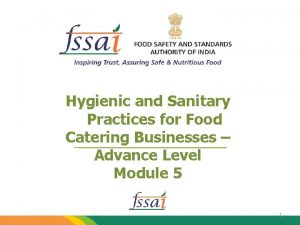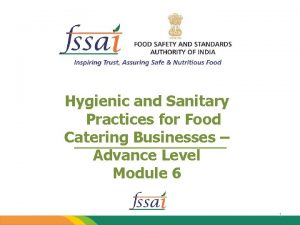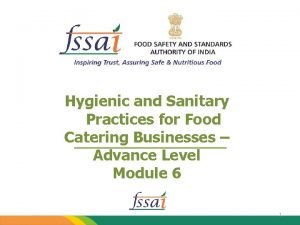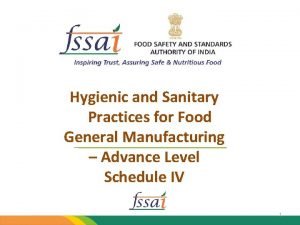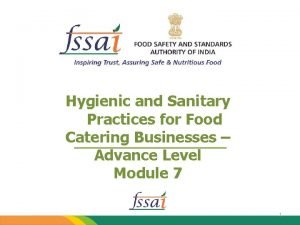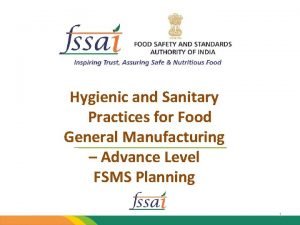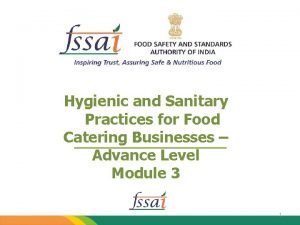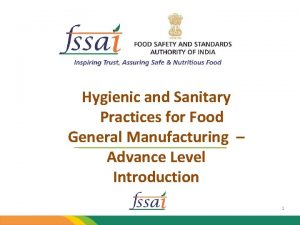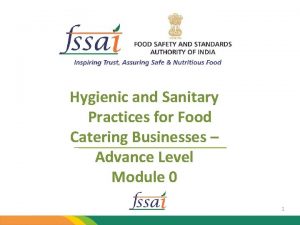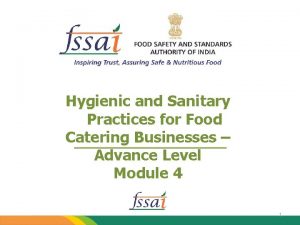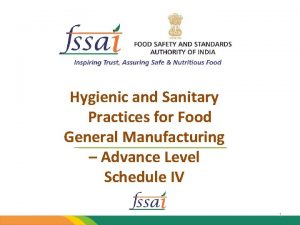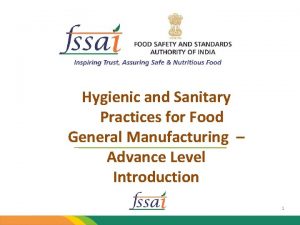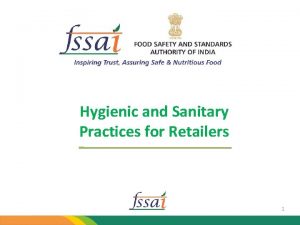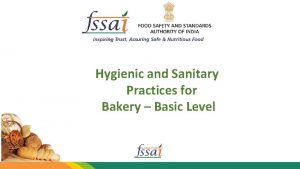Hygienic and Sanitary Practices for Food Storage Transport























































- Slides: 55

Hygienic and Sanitary Practices for Food Storage & Transport – Advance Level 1

What we will learn today • • • What & Why of Fo. STa. C What & Why of FOSCORIS What are FSSAI Audits and its relation in FLRS Technical requirements • GHP, GMP as per Schedule IV-Part II & V • Food Safety Control measures as per HACCP • Other FSSAI requirements Assessment (30 min)

FSSAI : Transforming Food Safety & Nutrition landscape in India

FSSAI Food Licensing & Registration Requirements Registration and Licensing

Lets check FBO with 4 MT / day capacity EOU FBO with 1 MT / day capacity Retailer with turnover of 16 Cr Distributor with turnover of 23 Cr Transporter with 68 vehicles with turnover of 70 Cr • Warehouse with capacity upto 50000 MT • Warehouse for frozen products above 10, 000 MT • • •

Registration & Licenses • • What is the difference between Registration and Licensing ? What are different categories of licenses? Who issues State license and Central licenses? How do you know if your business requires which license? Registration State License Central License

What documents are submitted for license? - Form B - Layout including proof of possession of premises - List of Directors including ID proof, partnership deeds - List of machinery & equipment - Authority Letter and nomination - Analysis report (Water, Product), NOC from CGWA - NOC from pollution control board / local municipality - List of workers with their medical fitness certificates* - Name, qualification and details of technical personnel / Fo. STa. C supervisor - Food Safety Management System Plan OR certificate - Recall plan

Why Fo. STa. C : Food Safety & Training Certification? The establishment in which food is handled, processed & packed, by the food business operator and the persons handling them should conform to the SANITARY & HYGIENIC requirements, FOOD SAFETY measures and OTHER standards. It shall also be deemed to be the responsibility of the food business

Types of Fo. STa. C courses? • Basic : (typically 4 hours) - Street Food Vendors - Catering - Retail & Distribution • Advanced : (8 hours) - Manufacturing, - Storage & Transport , - Catering, Retail & Distribution • Special: (8 – 16 hours) - Bakery

Other Training Agencies Training Partners approved by various Sector Skill Councils and other Govt Schemes Recognized Academic & Vocational Institutions: Licensed Food Businesses Association 100 Training Partners & still counting …

The FOSTAC Registration Step 1: Course Enrollment and generation of Admit card TRAINEE 1 or 2 years work experience for Advanced Step 2: Attend the course (Physical / Online for refresher) Step 3: Classroom Assessment Step 4: Give feedback on FOSTAC Portal Step 5: General your certificate TRAINER 7 years of Work Experience Assessor 7 years of Work Experience Training Partner 3 years of Work Experience

FOSCORIS Food safety compliance through regular inspection & sampling system

FOSCORIS • Web based system, real time digitalization of the reports using mobile • Create a district wise and state wise food safety Compliance matrix of the country. • Create a Food safety compliance verification platform. • Reduce the time of Inspection process and action initiated. • Build a transparent system within the inspections

Auditing Regulation • Auditing Regulations

Food Safety Management System

Before we proceed…. . Lets answer • What is the difference between Act, Rules, Regulations & Notifications? An Act to consolidate the laws relating to food and to establish the FSSAI for laying down science based standards for articles of food and to regulate their manufacture, storage, distribution, sale and import, to ensure availability of safe and wholesome food for human consumption and for matters connected therewith or incidental thereto.

What is FSMS ? As per FSSA Act, 2006 defines FSMS as ““Food Safety Management System” means the adoption Good Manufacturing Practices, Good Hygienic Practices, Hazard Analysis and Critical Control Point and such other practices as may be specified by regulation, for the food business. ” Schedule IV Good Hygiene Practices Good Manufacturing Practices Hazard Analysis & Critical Control Point (HACCP) Sector specific requirements – Part III, IV, V

Schedule IV • Part I: Street Food Vendors and Petty Food Operators • Part II: All Food Business Operators • Part III: Milk and Milk Products • Part IV: Meat and Meat Products • Part V: Food Service Establishments / Catering 18

What are schedule IV – part ii requirements?

Group Activity • Present the parameter given to you.

Introduction to Food Safety • Food Safety means assurance that food is acceptable for human consumption according to its intended use. • Food Safety Management System means the adoption Good Manufacturing Practices, Good Hygienic Practices, Hazard Analysis and Critical Control Point and such other practices as may be specified by regulation, for the food business. 21

What is FSMS as per FSSAI • FSS Act 2006 defines Food Safety Management System (FSMS) means the adoption Good Manufacturing Practices, Good Hygienic Practices, Hazard Analysis and Critical Control Point and such other practices as may be specified by regulation, for the food business. • For the purpose of this document and all assessments conducted there under, the definition of FSMS shall be read as the above and the requirements for this be taken as that defined under Schedule IV & Critical Control Point.

FSMS Program Based on FSSA Schedule 4 Compliance FSMS Plan FSMS Program

Schedule IV 1. Why? Section 16 of the FSSA, holds FSSAI responsible for regulating and monitoring the manufacture, processing, distribution, sale and import of food so as to ensure safe and wholesome food. 1. How? By introducing basic hygiene and safety requirements in the form of Schedule IV 1. Where in FSSR? The Schedule IV has been mandated for compliance by introducing it as a licensing requirement/condition under the Food Safety and Standards (Licensing and Registration of Food Businesses) Regulations, 2011.

Where does it impact? F i l i n g A p p l i c a t i o n 1 U n i q u e A p p l i c a t i o n N u 2 m b e P r o v i d i n g A d d i t i o n a l R e q 3 u i r 5 I n s p e c t i Insp ectio o n n of R Pre e mise p o r t 4 E i t h e r g r a n t o r r e j e c t a p p 6 l i c

Non-conformance may lead to 1. Under FSS (Licensing and Registration of Food Businesses) a) Notice/ rejection of application during inspection for licensing b) Notice/cancellation of license during periodic food safety audit by the Licensing Authority 2. Under Section 56 of FSSA a) Penalty of up to Rs one lakh for unhygienic or unsanitary processing or manufacturing of food under

Introduction to Food Safety Hazard - biological, chemical or physical agent in food, or condition of food, with the potential to cause an adverse health effect. Physical Chemical Food Hazards Biological Allergens 27

Introduction to Food Safety Physical Hazards Any foreign object (inanimate) found in the food or a naturally occurring object (bone in fillet), that poses; a hazard is called a ‘Physical Contamination’. Common Physical Hazards include : Glass Chipped pieces of cutlery and crockery Metal shavings from cans and foils Stapler pins Blades Plastic films used for wrapping or chipped pieces of disposables Lint and threads Band- aids Hair Finger nails Bones Jewellery pieces 28

Introduction to Food Safety Chemical Hazards Naturally occurring and Process Induced Chemical substances that can cause a food borne illness is called a ‘Chemical Contaminant or Hazard’. Process Induced Chemical Contaminants include : - Toxic metals in the catering set up or supply chain - Pesticides, Colorants - Cleansing products and sanitizers - Equipment lubricants - Chemical Food Additives, Preservatives Natural Chemical Contaminants include : - Ciguatoxin , Saxitoxin, Brevitoxin and Domoic Acid from Marine Algae - Histamine / Scombroid poisoning from fish 29

Introduction to Food Safety Biological Hazards Biological hazards are organisms, or substances produced by organisms, that pose a threat to human health. They are a major concern in food processing because they cause most food borne illness outbreaks. Major biological hazards include – - Bacteria ex: Salmonella spp. , Enterohaemorrhagic Escherichia coli, Campylobacter jejuni, Yersinia enterocolitica, Listeria monocytogenes, Bacillus anthracis, Bacillus cereus, Staphlococcus aureus, Clostridium botulinum, Clostridium perfringens, Vibrio vulnificus, Vibrio parahaemolyticus - Virus ex: hepatitis A virus, Norwalk viruses, Rotavirus - Parasites ex: Toxoplasma gondii, Cryptosporidia, Giardia spp. , Trichinella spiralis, Taenia solium, Anisakis spp. 30

Introduction to Food Safety Biological Hazards causes 1. Food Borne Infections result when a person consumes food containing pathogens; which grow in the human intestine and cause discomfort or disease. Typical symptoms of a ‘food borne Infections’ do not appear immediately. 2. Food Borne Intoxications result when a person consumes food containing toxins in it; that cause discomfort or disease. Typical symptoms of a ‘food borne Intoxication’ appear quickly. Food Borne toxin – mediated infections result when a person consumes food containing toxins produced by the pathogens in it; which grow in the human intestine and produce toxins that cause discomfort or disease. 31

Introduction to Food Safety Conditions favouring growth of Microorganisms Conditions FAT TOM Definition Food borne Microorganisms draw nutrients from Potentially hazardous foods Acidity Food borne Microorganisms grow well between the p. H range of most foods Temperature Microorganisms grow well between the temperature range of 5⁰C – 60⁰C, most commonly known as the ‘Danger Zone’ Time Microorganisms need sufficient time to grow; when exposed to the ‘Danger Zone’ Oxygen Microorganisms require oxygen in free or combined state; to favor their growth Moisture Microorganisms require moisture to grow and is measured in the form of ‘Water Activity (Aw)’ 32

Introduction to Food Safety ACTIVITY- 1 1. Food Hazards can be present in food when reduced to an acceptable level. True/False 2. Equipment Lubricant is a a. Physical Hazard c. Biological Hazard b. Chemical Hazard d. Allergen 3. Microorganisms grow well between the temperature range of. . . . . , most commonly known as the ‘Danger Zone’. a. 7⁰C – 74⁰C b. 5⁰C – 74⁰C c. 5⁰C – 60⁰C d. 7⁰C – 60⁰C 4. Food Borne. . . result when a person consumes food containing pathogens. a. Infection b. Intoxication • Fish bone in a fish gravy dish is a physical hazard. True/False 33

Introduction to Food Safety ALLERGENS 34

Allergens Cereals containing gluten Sulphite in concentrations Tree nuts and nut products of 10 mg/kg or more Allergens Crustacea and products of these Eggs and egg products Milk and milk products Fish and fish products Peanuts, soybeans and products of these 35

Allergen Management Allergies, Allergens & Food Handlers • What is the responsibility of a food company in Allergen Management? • What is the responsibility of the Food handler in Allergen Management? • What is the consumers responsibility in Allergen Management? 36

Foods Responsible for Allergic Reactions • • • Peanuts Tree Nuts Sesame Seeds Eggs Soybeans Milk Various grains and flours Fish Shellfish Sulphites (10 ppm) 37

Responsibility of a FBO in Allergen Management? • Provide safe, wholesome food to the marketplace. • Provide proper information with the product to allow the consumer to make an informed choice. 38

Provide Safe, Wholesome Food to the Marketplace. • • Allergen policy and program Risk Assessment Formulation Control Ingredient Management Process Controls Packaging Management Label Control Employee Training 39

Allergen Program – Production – Expectation of program environment – Training – Responsibilities – Restriction of non approved ingredients – Consequences – Marketing program – Be aware of – Hygienic practices employees with food allergies W 5 & – Have a response program in place How 40

Provide Safe, Wholesome Food to the Marketplace. • Policy, GMP, SOP, Monitoring, Deviation Procedure and Verification must state W 5 & How – Who – What – When – Where – Why – How 41

Formulation Control – No unapproved changes to formulation – Use only most recent approved formula – Follow SOP for scaling and use 42

Ingredient Management – Purchase only from approved suppliers – Purchase and use only approved ingredients – Store to prevent damage and cross contamination 43

Process Controls • • • Sequencing Products Scaling (Scoop & Bins) Shielded lines Rework Label control Cleaning of equipment 44

Provide Proper Information with the Product Label • • • Ingredient list Instructions for use Warnings Information Contact 45

Provide Proper Information with the Product • Accurate labelling is required by regulation. • Label misrepresentation is fraud • Knowingly selling a product with an undeclared allergen can be interpreted as a criminal offense in case of illness or fraud. 46

Responsibilities of the Food Handler • Advise of formulation or process inefficiencies • Use only approved ingredients • Do not make decisions which can affect food integrity or safety unless empowered and trained to do so • Use product rework only in the product for which it was originally produced • Understand your responsibilities • Understand do the job as trained 47

Responsibilities of the Food Handler • Prepare foods which contain known allergens after all other products have been produced, follow sequence as directed. • Avoid cross-contamination • Wash hands thoroughly after handling known allergens • Wash hands thoroughly after eating 48

Responsibilities of the Food Handler • Keep aprons and clothing free of allergens • Follow a very thorough sanitation program to prevent cross-contamination. • Keep dust down • Keep all ingredients closed when not in use • Use only specified equipment and utensils 49

Consumers Responsibility • • Report non conformities in labelling Educate family and Consumers Be aware of pitfalls Make educated decisions based on reliable information 50

Remember • • • Don’t assume all people can eat all foods Do your job as trained Do not make decisions for the consumer Do no cross contaminate Properly label all foods 51

Be Concerned Be Allergy Aware. 52

Introduction to Food Safety ACTIVITY-2 1. Eggs and egg products are allergens. True/False 2. Allergens and non-allergen product can be prepared in same containers without cleaning. True/False 3. Store allergenic ingredients or products separately to prevent minimize. . . . a. Production b. Waste c. Cross-contamination d. Space 4. Which foods and ingredients are known to cause hypersensitivity and shall always be declared. a. Chicken b. Red Meat c. Rice d. Milk 5. . . . is a powerful chemical that can cause a reaction in the respiratory system, gastrointestinal tract, skin or cardiovascular system. a. Cystine b. Histamine 1. Keratin d. Niacin 53

Introduction to Food Safety FOOD SPOILAGE 54

Introduction to Food Safety ACTIVITY- 3 1. Illness/injury to staff may lead to ……………. a. Food Spoilage b. Biological Hazard c. Allergens d. Cross-contamination. 2. ………………, right time, proper additives and understanding process steps is essential to ensure food safety. a. Wrong Temperature b. Cleaning of Utensils c. Allergens d. Right Temperature 3. ……………. , if not disposed in a scientific manner it can breed pest and micro organisms which is a threat to food safety. a. Physical hazard b. Chemical Hazard c. Waste d. Allergens 4. Right combination of time, temperature ventilation and segregation defines a good storage. True/False 5. Food zones must have ………………. humidity to ensure food safety. • More than 80% b. Less than 65% • More than 65% d. Less than 80% 55
 European hygienic engineering and design group
European hygienic engineering and design group Pontic and retainer
Pontic and retainer Modified ridge lap pontic
Modified ridge lap pontic Primary transport and secondary transport
Primary transport and secondary transport Primary active transport and secondary active transport
Primary active transport and secondary active transport Active transport diagram
Active transport diagram Secondary storage vs primary storage
Secondary storage vs primary storage Storage devices of computer
Storage devices of computer Find the unsafe storage practices in this picture
Find the unsafe storage practices in this picture Hyper v networking best practices
Hyper v networking best practices In keeping equipment and facilities safe and sanitary
In keeping equipment and facilities safe and sanitary Passive transport vs active transport venn diagram
Passive transport vs active transport venn diagram Passive transport vs active transport venn diagram
Passive transport vs active transport venn diagram Endocytosis vs exocytosis
Endocytosis vs exocytosis Primary active transport vs secondary active transport
Primary active transport vs secondary active transport Bioflix activity membrane transport active transport
Bioflix activity membrane transport active transport Bioflix activity membrane transport active transport
Bioflix activity membrane transport active transport Uses rigid metallic platters
Uses rigid metallic platters Unified storage vs traditional storage
Unified storage vs traditional storage Unit 2 food food food
Unit 2 food food food Food chain food chain food chain
Food chain food chain food chain Cross connection servsafe
Cross connection servsafe Sanitary landfill advantages and disadvantages
Sanitary landfill advantages and disadvantages Chapter 19 food safety and storage activity 1 answers
Chapter 19 food safety and storage activity 1 answers The flow of food purchasing receiving and storage
The flow of food purchasing receiving and storage Shellstock identification tags
Shellstock identification tags Improper food handling practices
Improper food handling practices Wholesome water
Wholesome water Trend sanitary
Trend sanitary Sanitary landfill
Sanitary landfill Sanitary supplies wholesaler
Sanitary supplies wholesaler Sanitary equipment design principles
Sanitary equipment design principles Las gallinas valley sanitary district
Las gallinas valley sanitary district Sanitary microbiology
Sanitary microbiology Sanitary microbiology
Sanitary microbiology Sanitary microbiology
Sanitary microbiology Epa sanitary survey
Epa sanitary survey Castelli sanitary
Castelli sanitary Fannings formula
Fannings formula Sanitary microbiology
Sanitary microbiology Sanitary plate
Sanitary plate Sanitary registration in el salvador
Sanitary registration in el salvador Sanitary survey
Sanitary survey Sanitary landfill
Sanitary landfill Pasco sanitary landfill
Pasco sanitary landfill Sausalito marin city sanitary district
Sausalito marin city sanitary district The sanitary report 1842 bbc bitesize
The sanitary report 1842 bbc bitesize Iso 22301 utbildning
Iso 22301 utbildning Typiska novell drag
Typiska novell drag Tack för att ni lyssnade bild
Tack för att ni lyssnade bild Vad står k.r.å.k.a.n för
Vad står k.r.å.k.a.n för Shingelfrisyren
Shingelfrisyren En lathund för arbete med kontinuitetshantering
En lathund för arbete med kontinuitetshantering Adressändring ideell förening
Adressändring ideell förening Tidbok
Tidbok Sura för anatom
Sura för anatom


